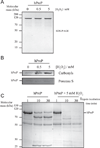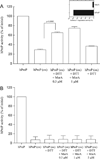In vitro oxidative inactivation of human presequence protease (hPreP)
- PMID: 23041349
- PMCID: PMC3589710
- DOI: 10.1016/j.freeradbiomed.2012.09.039
In vitro oxidative inactivation of human presequence protease (hPreP)
Abstract
The mitochondrial peptidasome called presequence protease (PreP) is responsible for the degradation of presequences and other unstructured peptides including the amyloid-β peptide, whose accumulation may have deleterious effects on mitochondrial function. Recent studies showed that PreP activity is reduced in Alzheimer disease (AD) patients and AD mouse models compared to controls, which correlated with an enhanced reactive oxygen species production in mitochondria. In this study, we have investigated the effects of a biologically relevant oxidant, hydrogen peroxide (H(2)O(2)), on the activity of recombinant human PreP (hPreP). H(2)O(2) inhibited hPreP activity in a concentration-dependent manner, resulting in oxidation of amino acid residues (detected by carbonylation) and lowered protein stability. Substitution of the evolutionarily conserved methionine 206 for leucine resulted in increased sensitivity of hPreP to oxidation, indicating a possible protective role of M206 as internal antioxidant. The activity of hPreP oxidized at low concentrations of H(2)O(2) could be restored by methionine sulfoxide reductase A (MsrA), an enzyme that localizes to the mitochondrial matrix, suggesting that hPreP constitutes a substrate for MsrA. In summary, our in vitro results suggest a possible redox control of hPreP in the mitochondrial matrix and support the protective role of the conserved methionine 206 residue as an internal antioxidant.
Copyright © 2012 Elsevier Inc. All rights reserved.
Figures





Similar articles
-
Degradation of the amyloid beta-protein by the novel mitochondrial peptidasome, PreP.J Biol Chem. 2006 Sep 29;281(39):29096-104. doi: 10.1074/jbc.M602532200. Epub 2006 Jul 18. J Biol Chem. 2006. PMID: 16849325
-
Mechanism of oxidative inactivation of human presequence protease by hydrogen peroxide.Free Radic Biol Med. 2014 Dec;77:57-63. doi: 10.1016/j.freeradbiomed.2014.08.016. Epub 2014 Sep 16. Free Radic Biol Med. 2014. PMID: 25236746 Free PMC article.
-
Molecular basis of substrate recognition and degradation by human presequence protease.Structure. 2014 Jul 8;22(7):996-1007. doi: 10.1016/j.str.2014.05.003. Epub 2014 Jun 12. Structure. 2014. PMID: 24931469 Free PMC article.
-
Mitochondria and Alzheimer's disease: amyloid-beta peptide uptake and degradation by the presequence protease, hPreP.J Bioenerg Biomembr. 2009 Oct;41(5):447-51. doi: 10.1007/s10863-009-9244-4. J Bioenerg Biomembr. 2009. PMID: 19798557 Review.
-
The organellar peptidasome, PreP: a journey from Arabidopsis to Alzheimer's disease.Biochim Biophys Acta. 2010 Jun-Jul;1797(6-7):1076-80. doi: 10.1016/j.bbabio.2009.12.016. Epub 2009 Dec 28. Biochim Biophys Acta. 2010. PMID: 20036633 Review.
Cited by
-
Loss of function of the mitochondrial peptidase PITRM1 induces proteotoxic stress and Alzheimer's disease-like pathology in human cerebral organoids.Mol Psychiatry. 2021 Oct;26(10):5733-5750. doi: 10.1038/s41380-020-0807-4. Epub 2020 Jul 7. Mol Psychiatry. 2021. PMID: 32632204 Free PMC article.
-
Molecular Targets in Alzheimer's Disease.Mol Neurobiol. 2019 Oct;56(10):7032-7044. doi: 10.1007/s12035-019-1563-9. Epub 2019 Apr 9. Mol Neurobiol. 2019. PMID: 30968345 Review.
-
An Exome-Wide Association Study Identifies New Susceptibility Loci for Age of Smoking Initiation in African- and European-American Populations.Nicotine Tob Res. 2019 May 21;21(6):707-713. doi: 10.1093/ntr/ntx262. Nicotine Tob Res. 2019. PMID: 29216386 Free PMC article.
-
The Role of a Pathological Interaction between β-amyloid and Mitochondria in the Occurrence and Development of Alzheimer's Disease.Acta Naturae. 2022 Jul-Sep;14(3):19-34. doi: 10.32607/actanaturae.11723. Acta Naturae. 2022. PMID: 36348714 Free PMC article.
-
Some Molecular and Cellular Stress Mechanisms Associated with Neurodegenerative Diseases and Atherosclerosis.Int J Mol Sci. 2021 Jan 12;22(2):699. doi: 10.3390/ijms22020699. Int J Mol Sci. 2021. PMID: 33445687 Free PMC article. Review.
References
Publication types
MeSH terms
Substances
Grants and funding
LinkOut - more resources
Full Text Sources
Molecular Biology Databases
Miscellaneous

